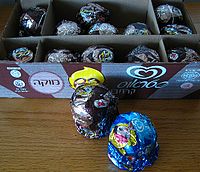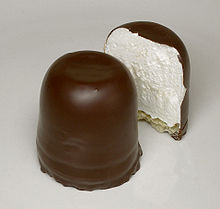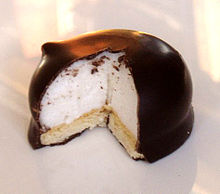- Chocolate-coated marshmallow treats
-
Chocolate-coated marshmallow treats are produced in different variations around the world, with several countries claiming to have invented it or hailing it as their "national confection." The first chocolate-coated marshmallow treat was created about 200 years ago in Denmark.[1]
Contents
National varieties
Chocolate teacake
In the United Kingdom this confection is known as a chocolate teacake,[2] although a teacake in England is usually a sweet bread roll with dried fruit which is served toasted and buttered. There are several manufacturers of chocolate teacakes in the UK, though the best known is Tunnock's, a Scottish company founded in 1890.[3] The Tunnock's teacake is commonly regarded in the same food category as the British biscuit, eaten at break times with a cup of tea as shown in advertising for the product.[4] The Tunnock's Teacake enjoys iconic status in Scotland,[5] evoking memories of childhood,[6] or symbolizing "home" for Scots around the world.[4] The Scottish National Blood Transfusion Service gives Tunnock's Teacakes to blood donors in Scotland after giving blood.[7] There is an online appreciation society for the Tunnock's Teacake[8] and Dundee University also has an appreciation society for the Tunnocks Teacake.[3] A giant fully edible replica of a Tunnocks Teacake was made by Michelle Kershaw and Nick Dodds at Pimp That Snack.[9]
The product itself consists of a small round shortbread base covered with a hemisphere of Italian meringue, a whipped egg white concoction similar to marshmallow.[10] As this soft white fondant is based on egg white rather than gelatine, it is much more delicate than marshmallow.[11] This is then coated in a thin layer of milk or plain chocolate and, in the case of Tunnock's, wrapped in a distinctive red and silver foil for the more popular milk chocolate variety, and a blue and gold wrapping for the plain chocolate type.
The argument about whether the teacake is a biscuit or a cake led to an action in the European Court of Justice by British company Marks and Spencer who argued that it had wrongly been classed as a biscuit and taxed by the UK government as such. The European court ruled that the Teacake was not, in fact, a biscuit but a cake and as such Marks and Spencer have begun a legal battle in the UK to retrieve the taxes paid which could amount to as much as 3.5 million UK pounds sterling ($5.6 million).[12][13]
Flødebolle/Negerbolle/Negerkys
In Denmark the confection is known as a flødebolle (cream bun), negerbolle (negro bun) or negerkys (negro kiss). As of The early 2000s, the "negro" names have been phased out by all major producers, as it is not seen as politically correct. Denmark also markets a variation shaped more like a patty, hence the name bøf (steak).
Denmark is arguably the largest producer of chocolate-coated marshmallow treats, producing approximately 800 million of these every year. The largest producer, Elvirasminde, produces roughly 650 million treats, sending 400 million abroad and leaving the remaining 250 million to be eaten by the Danish population, putting the amount of flødeboller eaten at 45 per Dane per year.[14]
Krembo
Krembo (Hebrew: קרמבו, literally "cream-in-it") is very popular in Israel, especially in the winter as an alternative to ice-cream.[15] It comes wrapped in colourful aluminium foil, and consists of a round biscuit base on the bottom and whipped egg whites cream from above, coated in a thin layer of chocolate. There are vanilla and mocha flavoured Krembos. In Hebrew, the word krembo is a combination of krem (cream) and bo (in it). The average krembo weighs 25 grams (0.882 ounces) and has 115 calories.[16] In Israel, the "krembo season" is from October to February. 50 million krembos are sold each year—an average of 9 per person in Israel.[16] According to a study funded by Strauss, Israel's leading krembo producer, 69% of Israelis prefer to eat krembos from the top down (starting with the cream), and only 10% start with the biscuit at the bottom; the rest had no preference.[16] Krembos are exported to the United States and Canada, and sold mostly in kosher shops and import stores.[17] The concoction was popular as a homemade sweet in Mandate Palestine in the 1940s, when it was known as Kushi (Hebrew: כושי, "negro"). It entered mass production in 1966. The first manufacturer, the Whitman Company, coined the name Krembo. A mocha flavour was introduced in 1967. In 1979 Whitman was acquired by Strauss-Elite. Today Strauss controls 54% of the krembo market in Israel.[16] In 2007, Nestlé introduced an ice cream variation of krembo called Lekbo (Hebrew: לקבו, "lick inside"). In the Hebrew version of Harry Potter and the Philosopher's Stone, Dumbledore's favourite sweet is a Krembo, rather than a sherbet lemon. The Krembo has become a pop-cultural/national icon. While considered a children's favourite, sociologists have found that it is consumed as a comfort food by Israeli expatriates in the United States.[18]
Mallomars
In the US, Mallomars[19] are produced seasonally at Nabisco. A graham cracker circle is covered with a puff of extruded marshmallow, then enrobed in dark chocolate, which forms a hard shell. Mallomars were introduced to the public in 1913, the same year as the Moon Pie (a confection which has similar ingredients). The first box of Mallomars was sold in West Hoboken, NJ (now Union City, NJ). Nabisco discusses it with a short story printed on Mallomar boxes.
Mallomars are generally available from early October through to April. They are not distributed during the summer months, supposedly because they melt easily in summer temperatures, though this is as much for marketing reasons as for practical ones.[20] Devoted eaters of the cookie have been known to stock up during winter months and keep them refrigerated over the summer, although Nabisco markets other fudge-coated cookie brands year-round. Seventy percent of all Mallomars are sold in metropolitan New York. The issue of Nabisco's choice to release Mallomars seasonally became a parodied topic on a sketch delivered by graphic artist Pierre Bernard on Late Night with Conan O'Brien.
According to the box, Mallomars are made in Canada by Kraft Foods. In Canada, these are known as "Dream Puffs."
Mohrenkopf
In German speaking Switzerland, they are commonly known as Mohrenköpfe (Moor's heads),[21][22] it's one of the European countries that still uses the original term. In the French speaking part of Switzerland they are known as Têtes Choco ("chocolate heads").[23]
Neekerinsuukot (Negerkyss)
In Finland, the name originated from Germany, and they were named "Negro Kisses" in 1951. In 2001, their name was changed to "Brunberg's Kisses", after the manufacturer, for largely the same reasons as in Denmark.[24]
Negerzoenen
In the Netherlands the name is Negerzoenen ("Negro kisses") or moorkoppen ("Moors' heads") though some companies have changed the name to the more politically correct Zoenen ("Kisses") reportedly due to claims of racism, similar to the German case where Negerkuss was renamed to Schokoküsse,[25] while actually the name-change was made for marketing reasons.[26]
Schokokuss / Mohrenkopf / Negerkuss / Vollidiot (without marshmallow)
Schokoküsse were first introduced in industrial numbers in 1920, although the first mention of them in Germany dates back to 1829. The sweets are sold all year long. Every year approximately one billion are sold.[citation needed] This makes an average of about one dozen per person per year. They are available in supermarkets, many bakeries and some schools. Sometimes they are consumed pressed between two halves of a bun, which is also referred to as a Matschbrötchen ("Squished Bread Roll")–mostly by children.[27]
These sweets are made of sweetened egg white foam and not marshmallows. In most cases the used sweetener is sugar, but there are also sugar-free products with sugar substitutes on the German market. The consistency is quite fluffy and not sticky or gooey.
They were first only known under the names Mohrenkopf ("Moor's Head") or Negerkuss ("Negro's Kiss"), but most companies changed the official product-name in the 1980s[citation needed] to the more neutral Schokokuss ("Chocolate Kiss"), Schaumkuss ("Foam Kiss") or to brand-specific names (the most famous brand being Dickmann's). In the South and the West of Germany they are still commonly known as Mohrenkopf. In Austria they are referred to as Schwedenbomben ("Swedish bombs").
Whippets
Whippet cookies are produced in Montreal, Quebec, Canada. They consist of a biscuit base topped with marshmallow-like filling and then coated in a hard shell of pure chocolate. Whippet cookies first came to the market in 1927, although they had been produced and distributed by Viau under the name "Empire" as early as 1901. Today, the cookies are still produced in Montreal at the east end of the Viau factory, which is now owned by Dare Foods. They are currently available with both dark chocolate and milk chocolate coatings, and with several flavors of artificial fruit jam filling inside the marshmallow-like filling.
The cookies are similar to Mallomars of New York City, except that Whippets can be produced throughout the year because Montreal and its surrounding areas have a lower average temperature than New York.[dubious ] They also bear a striking resemblance to Tunnock's Tea Cakes as well as Krembos. However, the Tunnock tea cake does not have the same kind of chocolate and a different type of filling.
The Whippet cookie is a distinct part of Quebec culture because it does not travel well outside its area of production. This is partly because the pure chocolate melts very easily (compared with a chocolate mixture) and therefore they require refrigerated transport in summer. Furthermore, the combination of the hard chocolate shell and the air-filled inner marshmallow make them self-destruct when placed in the unpressurized or semi-pressurized cargo section of an airplane. However, they are currently available at various grocery locations throughout Canada and the US.
An episode of the Canadian science program How It's Made showed the production process behind the cookie. However, many aspects of the production process (the amount of marshmallow filling, the ingredients, etc.) were not revealed. The show's narrator described these aspects as "classified information." As Canadian law requires an ingredient list on each package, the amount of confidential information involved is limited.
Another Canadian cookie, "Viva Puffs", is produced by Dare Foods in five flavours. Viva is a trade name; these confections have been known in (English) Canada for at least 50 years as "chocolate puffs".
Choco Mallows
In the Philippines, Fibisco makes a product similar to Mallomars called Choco Mallows that, unlike Mallomars, is available year-round. Likely due to the tropical climate, the "hard chocolate shell" of a Choco Mallow is usually just a soft chocolate covering that does not completely harden even after being refrigerated. Choco Mallows are usually covered in foil and sold in boxes of six, although street vendors and small corner stores may also sell them by piece.
Beso de Moza
In Peru, the confections are known as "Beso de Moza" (Girl's Kiss)(link). Sold by Nestle. Currently there is a contest between strawberry and lucuma flavor becoming a permanent flavor. Also exists in Ecuador.
In Colombia, it's called Beso De Negra (Black Woman's Kiss) or "Chocmelo', a portmanteau of chocolate and masmelo (marshmallow). However, these last ones don't always have a cookie as its base.
Bombocas
In Portugal, these confections are known as "Bombocas". Sold by different brands, usually the supermarket ones. They are sold in 3 main flavors: meringue (white interior), strawberry (pink) and vanilla (yellow). They are being called "Beijinhos" in the last few years.
MallowPuffs
In New Zealand biscuit manufacturers Griffin's make MallowPuffs, a chocolate biscuit that is described as a "light fluffy marshmallow sitting on top of a shortcake biscuit, covered in luxurious milk chocolate".[28] The marshmallow in MallowPuffs tends to be more dense and rubbery than in some similar products (such as Tunnock's chocolate teacakes). They come in a variety of flavours, including Cookies and Cream, Hokey Pokey, Toffee, Rocky Road, Double Chocolate and original chocolate. The slogan from a national advertising campaign for MallowPuffs, "Have you done enough for a MallowPuff", has entered into the New Zealand cultural lexicon.
Other varieties
In Flanders, the confection is known as Negerinnentetten (negress tits), although the manufacturers market it under a less offensive name. In fact its other name, Negertetten comes from tête de nègre. When it first went on the market in Ghandour, Lebanon, the name was ras el abd (slave's head); it has since been changed to Tarboush (Fez)[citation needed]. Similar products in North America are Wagon Wheels and Puffs. In Australia the closest product is Arnott's Chocolate Royals, which are available in milk and dark chocolate varieties, and are similar in appearance to a Tunnock's teacake. A similar confection in Russia is Zefir (зефир) though usually made without a biscuit. The filling is fruit-flavored, and either soft or similar to a meringue. Choco Pie, produced by Orion Confectionery in Korea, are similar to the North American MoonPie and Scooter Pie. In South Africa, they are known as Sweetie Pies.
References
- ^ Jerusalem Post: Israelis consume 50 million 'krembos' every year
- ^ Teacake set to cost taxman £3.5m BBC News report
- ^ a b "Sweettooth fans swamp Tunnock's tours". Scotland On Sunday. The Scotsman. Archived from the original on 2011-04-24. http://www.webcitation.org/5yBkZozIW. Retrieved 2008-09-27.
- ^ a b "Video showing Scotsman being welcomed home to Tunnock's Teacakes and a mug of tea.". http://beesnees1.co.uk/beesnees/work_movie.asp?work=32&page=2. Retrieved 2008-09-20.[dead link]
- ^ "Tunnock's Teacakes "genuine Scottish icons" according to "British Delights" website". http://www.britishdelights.com/tunnocks-teacakes.htm. Retrieved 2008-09-20.
- ^ "A recognised favourite Scottish memory - Tunnock's Teacakes". http://www.taste-of-scotland.com/scottish_food_products_breadsplate.html. Retrieved 2008-09-20.
- ^ "The Scots Independent Newspaper on giving blood". http://www.scotsindependent.org/2007/071207/index_p.htm. Retrieved 2008-09-27.
- ^ "Tunnock's Teacake Appreciation Society". http://upload.bebo.com/Profile.jsp?MemberId=2483699913&ShowSims=Y. Retrieved 2008-09-20.
- ^ "Pimp That Snack make a Tunnocks Teacake". http://www.pimpthatsnack.com/project.php?projectID=311. Retrieved 2008-09-27.
- ^ Robert Lea (2010-04-14). "The Willy Wonka of Tannochside: Tunnock’s MD, Boyd Tunnock". London: The Times. Archived from the original on 2011-04-24. http://www.webcitation.org/5yBjcW1Be. Retrieved 2011-04-24.
- ^ ""Tunnocks Teacake" biscuit of the week". "Nice Cup of Tea and a Sit Down". http://www.nicecupofteaandasitdown.com/biscuits/previous.php3?item=23. Retrieved 2008-09-20.
- ^ "BBC report on debate over status of teacake - cake or biscuit". BBC News. 2008-04-10. http://news.bbc.co.uk/1/hi/world/europe/7340101.stm. Retrieved 2008-09-27.
- ^ "Management Today Business magazine on the Teacake name debate". http://www.managementtoday.co.uk/search/article/773818/the-great-teacake-mistake/. Retrieved 2008-09-27.
- ^ Erhvervsbladet.dk
- ^ Haaretz.com
- ^ a b c d "10 Things you don't know about a krembo" (in Hebrew). Yedioth Ahronoth. 2003-11-07. http://www.ynet.co.il/articles/0,7340,L-2813501,00.html. Retrieved 2007-01-20.
- ^ "פיתוח ישראלי חדש: קרמבו גלידה" (in Hebrew). Yediot Aharonot. 2007-02-07. http://www.ynet.co.il/articles/0,7340,L-3361646,00.html. Retrieved 2007-02-07.
- ^ Jews of Brooklyn Ilana Abramovitch and Sean Galvin, Brandeis University Press, ISBN 1-58465-003-6
- ^ The Mallomar
- ^ Homestead.com
- ^ Mohrenkopf Dubler
- ^ Schokoladenfabrikation - Unsere Produkte
- ^ Têtes Choco Perrier
- ^ Brunbergin Suukot
- ^ Newspaper article on "Negerzoen" namechange
- ^ [1] Buys on changing the name of their "negerzoenen" to "zoenen"
- ^ Guide to German Cookies, Cakes, Desserts and Confectioneries
- ^ MallowPuffs by Griffins. Retrieved 2011-05-14
External links
- Food Timeline: History notes
- Salon.com: a brief reminiscence of Mallomars
- "The Cookie That Comes Out in the Cold" at The New York Times
Chocolate Background Outline of chocolate · History of chocolate · Health effects of chocolate · History of chocolate in Spain
Origins Varieties Chemicals See also Categories:- Marshmallows
- Scottish cuisine
- Danish cuisine
- German cuisine
- Finnish cuisine
- Quebec cuisine
- German desserts
Wikimedia Foundation. 2010.






